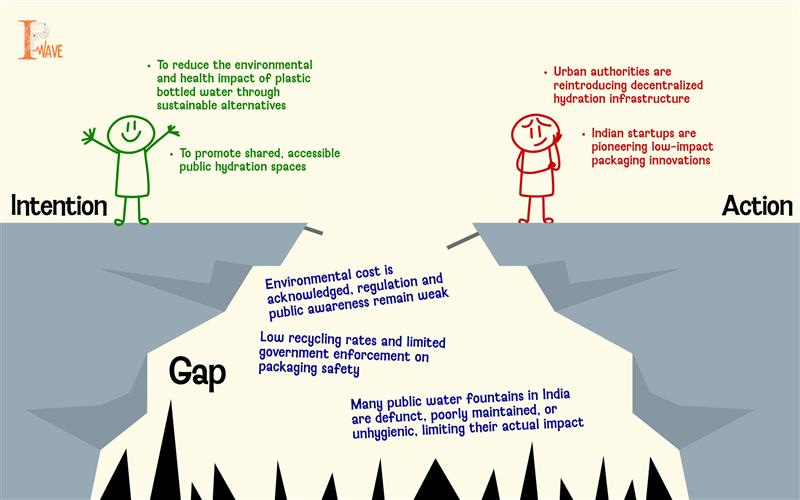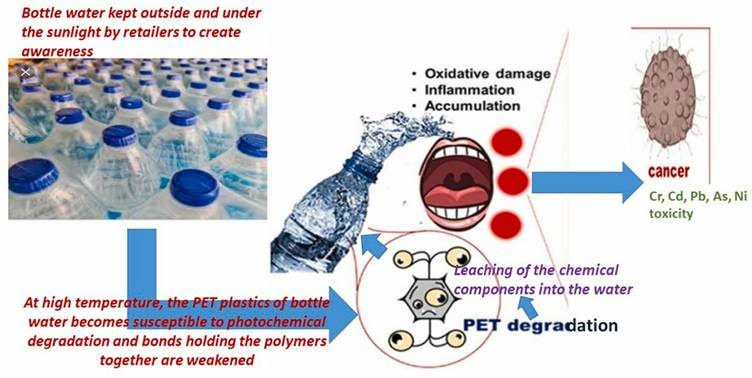Public Water, Private Bottles: Health, Environment, and the Decline of Shared Hydration Spaces
If you've ever crumpled up a plastic water bottle with the best of intentions not to dispose of it—you're not alone. We all know plastic is bad, not only for the environment but for our well-being too. Yet, nearly every Indian refrigerator still contains a couple of used plastic water bottles, filled up and reused again and again. Author Peter H Gleick in his fascinating book, “Bottled and Sold: the story behind our obsession with bottled water” captures the lost world (as old as ancient Greece) of shared drinking water fountains and the history of ubiquitous public drinking fountains, and the aggressive marketing of BW from early 1970’s & 80’s.
A Look at the Numbers
As indicated by the British Medical Journal Global Health (2024), more than one million plastic bottled waters are purchased every minute worldwide. GreenMatch UK approximates that in 2024 alone, 500 billion plastic bottles are consumed worldwide, the fastest growing beverage market in the world. Meanwhile, 2 billion individuals do not have access to safe water for drinking, hence BW is an imagined safe substitute. According to Statista, the market size of branded and non-branded BW in India is 289 billion INR in the year 2023.
But this increased dependence on BW warrants serious examination. While access is a need for many, the storage and packaging of bottled water pose serious health and environmental issues. A Study done by Orb media in 2017, found that on average tested samples of BW (250, 11 different brands) have 10.4 particles of plastic per litre that were 100 microns or even bigger along with many smaller plastic particles. The European Drinking Water Directive in 2024 has given the mandate to include microplastics on the “watch list” of emerging compounds.
Health Risks Hidden in Plastic
The bottled water's safety is not assured. Storage—particularly at high temperatures or exposure to sunlight—can lead to the leaching of toxic chemicals such as Bisphenol A (BPA) and phthalates. These have been linked to neurological, gastrointestinal, endocrine, and immune system disturbances, and even obesity through deranged lipid metabolism.
One 2024 study published in the New England Journal of Medicine links microplastics to increased risks of strokes, myocardial infarctions (commonly known as heart attacks), and premature deaths. Alarmingly, plastic contamination in bottled water ranges from 10% to as high as 78%, and even so-called BPA-free bottles are not free from harm due to the presence of other toxic plasticizers.
Also, research involving plastic bottles that were left under sunlight indicated leaching of heavy metals like lead, cadmium, arsenic, and nickel, which are linked with cognitive impairment, neurodegenerative conditions, and cancer.
Environmental Impact: The Price of Convenience
Plastic bottles comprise almost 11.9% of total plastic marine litter, and plastic bottles all over the world are recycled in only 9%—a percentage that varies significantly across nations. With a decomposition period of hundreds of years, these bottles fill landfills and ecosystems as well. In London, campaigns such as #OneLess (focused on behavioral intervention) reduced plastic bottle consumption by encouraging refilling. From 2016 to 2021, the campaign saved 9 million single-use bottles, brought 981,000 refills through drinking fountains, and initiated a drive for mass public fountain installation.
Bottled Water: More Taste, Less Necessity?
Others enjoy BW just for the taste. Some brands fortify their water with flavorings, carbonation, or cold storage, which can affect perception. However, this marketing strategy tends to overwhelm the dangers involved in long-term consumption of packaged water.
India's Plastic Challenge
India's consumption of bottled water increased from 15,051 million litres in 2013 to 23,105 million litres in 2021. The industry is expected to hit more than 110 million consumers by the year 2029. Due to the haphazard availability of purification equipment such as RO filters, most Indian households buy 20-litre containers from private operators at ₹30–₹40 per filling, depending on location.
While this, the FSSAI (2024) has placed packaged drinking and mineral water in high-risk food groups that need to be strictly inspected. Yet, countless small enterprises run on basic licenses with little to no inspection. FSSAI has also a mandate for very small- or large-scale businesses who sells the packaged BW to apply for food safety registrations.
Eco Friendly startups and Innovation
Prominently, Kerala has led the way. A court order now bans plastic bottles at weddings, citing damage to the environment. The state also disapproved of the Railways' plastic waste and suggested prohibitions in ecologically sensitive hilly regions.
A start-up based in Kerala, funded by KIIDC, has launched India's first compostable, biodegradable water bottle under the brand name Hilly Aqua. With certified biodegradable materials, the project plans to substitute traditional plastic bottles completely.
Kevala Niru, another Indian brand, provides eco-friendly options such as Boxed Aqua and Alkind Wtr in GableTop Pak cartons, abandoning plastic and glass packaging completely. Drinking Water fountains have been part of our culture and our lives since very long. Currently, according the numbers from Poidata, there are approx. six thousand drinking water fountains in India, with highest in Bengaluru. As part of Delhi Heat Action Plan, 2025, the city is planning to install several small RO water dispensers (Jal Doot) across various key locations including bus shelters. Mumbai is also restoring old British era drinking fountains (Pyaavs) to revive the culture of shared water spaces and reduce reliance on BW. However all these initiatives have their own limitations. In Cuttack, for instance, there are several water coolers were found to be defunct and those which are running are poorly maintained and there are hygiene challenges.
To meet the global demand of water, we use one million of plastic in the form of BW. The bottled water business flourishes based on both need and perception. As much as access to safe drinking water continues to be an important issue, particularly in low-resource environments, the health and environmental implications of plastic bottled water cannot be overemphasized.




